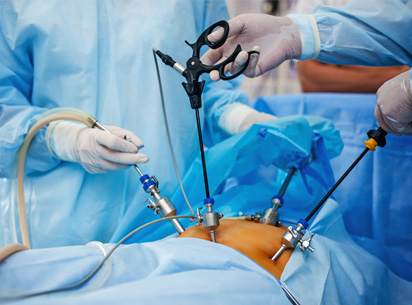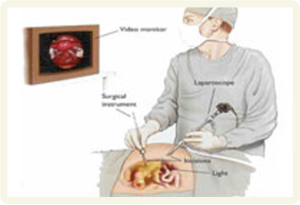Laparoscopy or endoscopy procedure means looking inside and typically refers to looking inside the body for medical reasons using an endoscope, an instrument used to examine the interior of a hollow organ or cavity of the body.
What is Laparoscopy ?
The laparoscopy operation is a surgical procedure that involves making one, two, or three very small cuts in the abdomen, through which the doctor inserts a laparoscope and specialized surgical instruments. A laparoscope is a thin, fiber-optic tube, fitted with a light and camera. Laparoscopy in gynaecology allows your doctor to see the abdominal organs and sometimes make repairs, without making a larger incision that can require a longer recovery time and hospital stay.


Endoscopy & Laparoscopy
- Diagnostic Laparoscopy
- Laparoscopic Myomectomy for Fibroids
- Laparoscopic Cystectomy for Ovarian Cyst & Fibrial Cyst
- Laparoscopic Tubal Recanalisation
- For Ectopic Pregnancy
- Laparoscopy Assisted Vaginal Hysterectomy
- Total Laparoscopic Hysterectomy
- Laparoscopic Ovarian Drilling / Wedge Resection for PCOS Ovary.
- Laparoscopic Adhesiolysis
- Laparoscopic
- Endometriotic Surgery for Gr I-IV Endometriosis
Why is laparoscopy important?
Some causes of infertility, like endometriosis, can only be diagnosed through laparoscopy. Laparoscopy allows your doctor to not only see what’s inside your abdomen, but also biopsy suspicious growths or cysts. Also, laparoscopic surgery can treat some causes of infertility, allowing you a better chance at getting pregnant either naturally or with fertility treatments. Laparoscopy can be used to remove the scar tissue that’s causing pain.
How is laparoscopy done?
Laparoscopy is performed in a hospital, under general anaesthesia. Your doctor will give you instructions on how to prepare for surgery beforehand. You will probably be told not to eat or drink for 8 or more hours before your scheduled surgery, and you may be instructed to take antibiotics. You’ll receive an IV, through which fluids and medication to help you relax will be delivered. The anesthesiologist will place a mask over your face, and after breathing a sweet smelling gas for a few minutes, you’ll fall asleep.
Once the anesthesia has taken effect, the doctor will make a small cut around your belly button. Through this cut carbon dioxide gas will be used to fill your abdomen. This provides room for your doctor to see the organs and move the surgical instruments. Once your abdomen is filled with gas, the surgeon will then place the laparoscope through the cut to look around at your pelvic organs. The surgeon may also biopsy tissue for testing. Sometimes two or three more small cuts are made, so that other thin surgical instruments can be used to make repairs or move the organs around for a better view.
What is done during laparoscopy?
Depending on what is wrong, the surgeon may treat the problem during the same surgery. Adhesions, endometrial growths, cysts, and fibroids may be removed in some cases. If the fallopian tubes are blocked, they may be opened, if possible. If an ectopic pregnancy is found, the surgeon will remove the abnormal pregnancy and repair any tissue damage. He or she may need to remove the entire fallopian tube.
After surgery, your doctor will explain what your options are for getting pregnant. If you had fibroids removed or a fallopian tube repaired, you may be able to try to get pregnant without help. Also, in the case of endometriosis or PID, the removal of scar tissue may make it possible to get pregnant without further treatment. Depending on the findings during laparoscopy, your doctor may recommend fertility treatments.
What are the advantages of laparoscopy in infertility treatment ?
It will allow the diagnosis of infertility problems that would otherwise be missed in the absence of laparoscopy. For example, a woman who has severe endometriosis can be identified by using ultrasound. A woman with mild endometriosis can only be identified using surgery such as laparoscopy. Another problem that can only be identified through surgery are pelvic adhesions. Also known as scar tissue, adhesions cannot be seen with ultrasound, x-rays or CT scans. Adhesions can interfere with the ability to conceive if they make it more difficult for the egg to get into the fallopian tube at the time of ovulation.
Many people view laparoscopy as a less invasive surgery that traditional surgery. Traditional surgery requires making an incision in the abdomen which is several centimeters long. This in turn means that the patient has to spend two to three nights in the hospital. Laparoscopy utilizes one to three smaller incisions. Each incision may be one half a centimeter to a full centimeter in length. Most often, patients who have had a laparoscopy will be able to go home the same day as the surgery. In other words, a hospital stay is not usually required. Some people believed that laparoscopy would result in less adhesions being formed after reproductive surgery. However, this does not appear to be true.
What are the disadvantages of laparoscopy in infertility treatment ?
Requires a different set of skills compared laparoscopy to traditional surgery. In many cases, it can be more challenging to complete a procedure. For example, removing one superficial medium sized fibroid can be accomplished equally well through laparoscopy or traditional surgery. However, a woman that has dozen of fibroids, large and small with some occupying the deep layers of the uterus is much better served with a traditional surgery. A good fertility doctor will know when laparoscopy is an advantage and when it is a liability.
Which infertile patients should have laparoscopy ?
Generally, laparoscopy should be reserved for couples who have already completed a more basic infertility evaluation including assessing for ovulation, ovarian reserve , ultrasound and hysterosalpingogram for the female and semen analysis for the male. Some couples may elect to skip laparoscopy in favor of proceeding to other fertility treatments such as superovulation with fertility medications combined with intrauterine insemination or in vitro fertilization .
There may be instances in which the fertility doctor may have a high suspicion for finding problems with laparoscopy. for instance, if a woman had a history of a severe pelvic infection or a ruptured appendix, this would increase the likelihood that she may have pelvic adhesions and therefore more likely to benefit from laparoscopy.
How will I feel during and after laparoscopy ?
During laparoscopic surgery, you’ll be under the effects of general anesthesia, so you should not feel any pain, nor remember the procedure. When you wake up, you may have a sore throat, caused by a tube that is placed there to help you breath during surgery (but is removed before you wake-up). It’s normal for the area around the cuts to feel sore, and your abdomen may feel tender, especially if your doctor removes a lot of scar tissue. You may feel bloated from the carbon dioxide gas, and you may experience sharp pains in your shoulder. This should go away in a few days.
You should plan on taking it easy for at least one or two days. You may need a week or two to recover if many repairs were made. Be sure to speak to your doctor on what to expect. He or she may also prescribe pain medication and antibiotics.